WHILE recently looking through Harold Hersey’s short-run aviation titles, I came upon what I thought was a new series we could feature on the site, or maybe in a book if there were enough stories. Thumbing though the first issue of Hersey’s Eagles of the Air there was an ad for the next issue stating, “Another Story of The “WASPS”"

I looked in the next issue and there they were as well as running in three of the other seven issues of the run—five tales in all. I scanned the pages to read later and continued searching through the various titles.
Later, while reading the first one, I was thinking this all sounds so familiar. I was thinking this was a story I had just read—and it was, but then it was a story staring Ralph Oppenheim’s “Three Mosquitoes,” not D. Campbell’s “Three Wasps.” So I pulled up the Mosquitoes version of the story and Campbell’s story was a virtual word-for-word copy of of Oppenheim’s—all he did was change the names of the characters.

So Kirby, the young impetuous leader of the Three Mosquitoes becomes Gary, the young impetuous leader of the Three Wasps. “Shorty” Carn, the mild-eyed, corpulent little Mosquito becomes the mild-eyed, corpulent “Shorty” Keen, complete with briar pipe in Campbell’s Wasps. To complete the inseparable trio, Travis, the oldest and wisest of the Mosquitoes, has his name changed to Cooper.

The Text. A portion of the D. Campbell’s “Dangerous Business” (Eagles of the Air, Nov 1929) on the left and the similar passage from Ralph Oppenheim’s “Stacked Cards” (War Birds, Jul 1928) on the right.
I couldn’t believe it. So I checked out the Wasps story in the next issue and it was the same thing. And so on with the other three—sometimes even forgetting to change “Mosquitoes” to “Wasps”. All five stories were plagiarized from Oppenhiem’s stories. Instead of just stealing a random story like Robert A. Carter had done, D. Campbell was plagiarizing a whole series!
It seemed a bold move that nobody seemed to notice. Weirdly, I could find no mention of it in the newspapers of the time. The only hint of something being up was pointed out by a reader whose letter ran in the same issue as the final Wasps story.

So who was this D. Campbell? I thought at first it was just an alias for Oppenheim who was simply trying to repackage his Three Mosquitoes stories as The Three Wasps and get paid for them again—’cause nobody would be so bold, but D. Campbell it turns out, is an actual guy.
Donald Marr Campbell was born on September 2nd, 1904 in Cambellton, Texas and had his first story in the pulps, “King Ranch,” in the February 11th, 1928 issue of West. He’s credited with a couple dozen stories that run the gamut from aviation to detective to spy to westerns with his last appearing in the March 1932 issue of The Shadow
Campbell listed his occupation as Cafe Operator in the 1940 census and signed up for the war effort in 1942. Sadly, in the 1950 census he is listed as being unable to walk. He moved to Houston in 1956 where he lived until he passed away in 1974 at the age of 69 following an extended illness.
Looking at some of his other published stories, it turns out there was an earlier plagiarized Wasp story that appeared in the April 1929 Flying Aces. This would make it the first of the Wasp stories. The issue also include a letter of thanks for publishing from Campbell!

In all Campbell had six stories of the Wasps published. Each was a virtual word for word copy of a preexisting story of the Three Mosquitoes by Ralph Oppenhiem. They were:
- Flying To Glory (Flying Aces, Apr 1929) is based on Oppenheim’s Down from the Clouds (War Stories, Aug 19, 1927)
- Reckless and Lucky (Eagles of the Air, Oct 1929) is based on Oppenheim’s Two Aces~and A Joker (War Birds, Jun 1928)
- Dangerous Business (Eagles of the Air, Nov 1929) is based on Oppenheim’s Stacked Cards (War Birds, Jul 1928)
- Luck of the Wasps (Eagles of the Air, Jan 1930) is from Oppenheim’s An Ace In The Hole (War Stories Mar 29, 1928)
- Three Flying Fools (Eagles of the Air Feb 1930) is from Oppenheim’s Get That Gun (War Stories Nov 8, 1928)
- The Wasps (Eagles of the Air Mar 1930) is from Oppenheim’s Two Aces—In Dutch (War Stories, Dec 6, 1928)
But what better way than to see for yourself. So we’ll be posting couple of the Wasps’ adventures over the next week. As the Three Mosquitoes and the Three Wasps would both say, “Let’s Go!”
The first of D. Campbell’s Three Wasps stories appeared in the pages of the April 1929 Flying Aces. The greatest fighting war-birds on the Western Front roar into action. The three Spads flying in a V formation so precise that they seemed as one. On their trim khaki fuselages, were three identical insignias—each a huge, black-painted picture of a grim-looking wasp. In the cockpits sat the reckless, inseparable trio known as the “Three Wasps.” Captain Gary, their impetuous young leader, always flying point. On his right, “Shorty” Keen, the mild-eyed, corpulent little Mosquito, who loved his sleep. And on Kirby’s left, completing the V, the eldest and wisest of the trio—long-faced and taciturn Cooper.
A new C.O. has been assigned 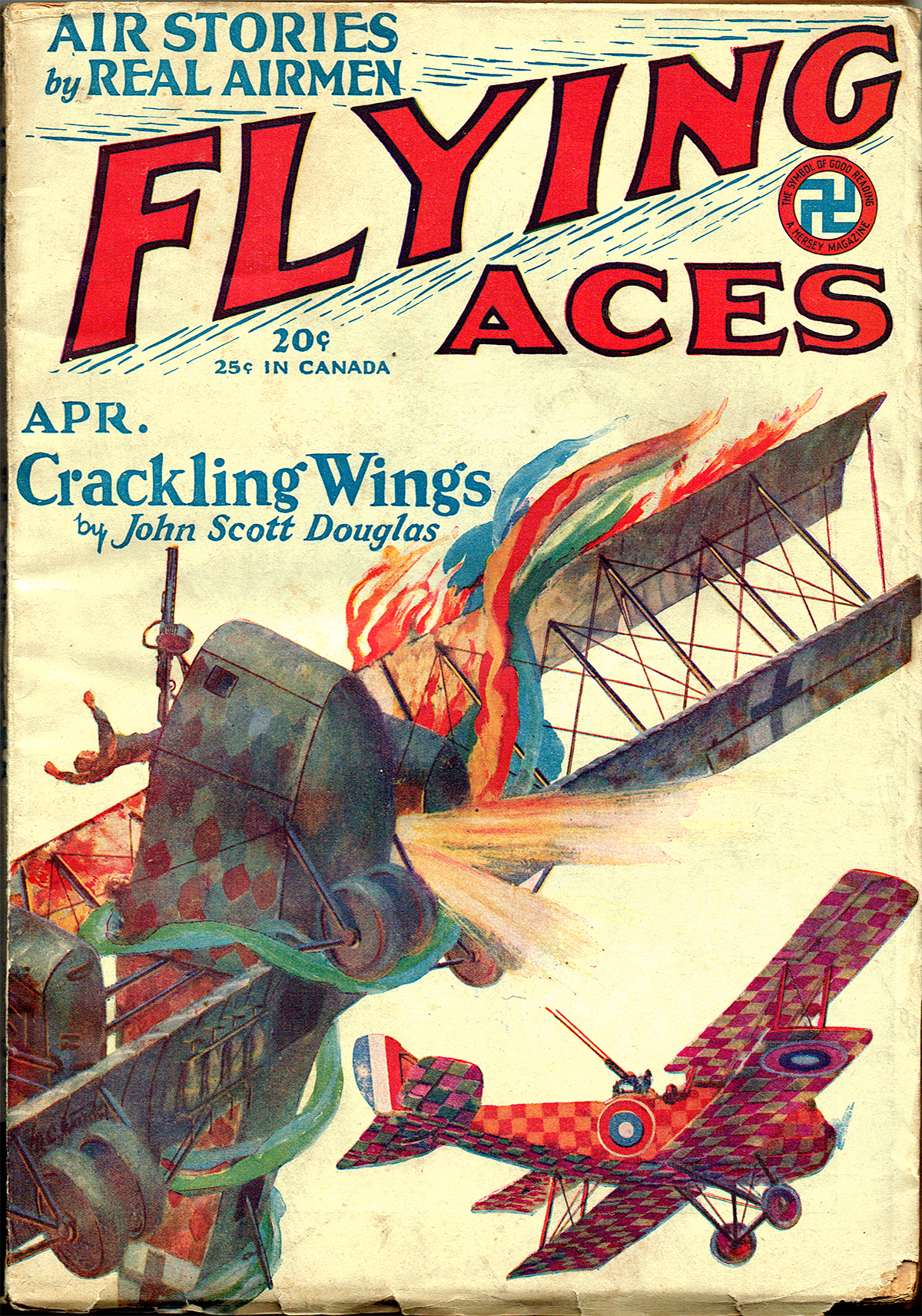 to the squadron and he can’t stand pilots who “grand-stand” which is the Mosquitoes stock-in-trade and boy do they catch hell when they get on the C.O.’s wrong side—that is until the C.O. gets in a jam and it’s trick flying that’ll save him when the Boche attack!
to the squadron and he can’t stand pilots who “grand-stand” which is the Mosquitoes stock-in-trade and boy do they catch hell when they get on the C.O.’s wrong side—that is until the C.O. gets in a jam and it’s trick flying that’ll save him when the Boche attack!
The C.O. called them babies and forbade stunt flying. Not content with that he separated the Three Wasps, the greatest flying, fighting trio he had. Hatred was rampant. But all this was forgotten when the great call came!
Compare this to Oppenheim’s original version of the story with The Three Mosquitoes!
Down from the Clouds
The C.O. of the flying field was sore—the Three Mosquitoes, dare-devils supreme were doing their “grand-stand stuff” again. But when the C.O. found himself in difficulties, with Boche planes swarming all around him—things were different. The best flying story of the month.
And check back on Friday when the Wasps will be back with another exciting adventure!
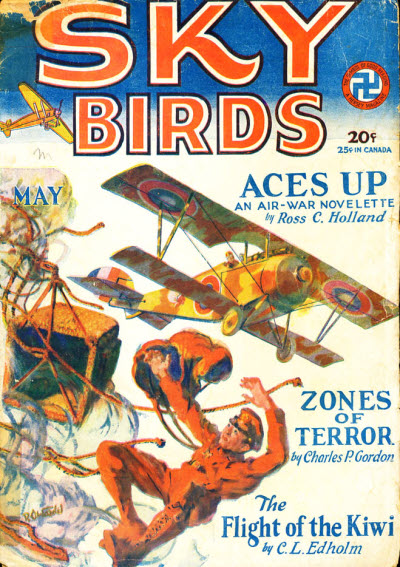 another story from one of the new flight of authors on the site this year—Andrew A. Caffrey. Caffrey, who was in the American Air Service in France during The Great War and worked for the air mail service upon his return, was a prolific author of aviation and adventure stories for both the pulps and slicks from the 1920’s through 1950. Here Caffrey tells the tale of Loop Murry, stunt flier for the movies who learns there’s sometime more to a man than meets the eye. From the May 1929 number of Sky Birds, it’s Andrew A. Caffrey’s “The Vanishing Ace!”
another story from one of the new flight of authors on the site this year—Andrew A. Caffrey. Caffrey, who was in the American Air Service in France during The Great War and worked for the air mail service upon his return, was a prolific author of aviation and adventure stories for both the pulps and slicks from the 1920’s through 1950. Here Caffrey tells the tale of Loop Murry, stunt flier for the movies who learns there’s sometime more to a man than meets the eye. From the May 1929 number of Sky Birds, it’s Andrew A. Caffrey’s “The Vanishing Ace!”




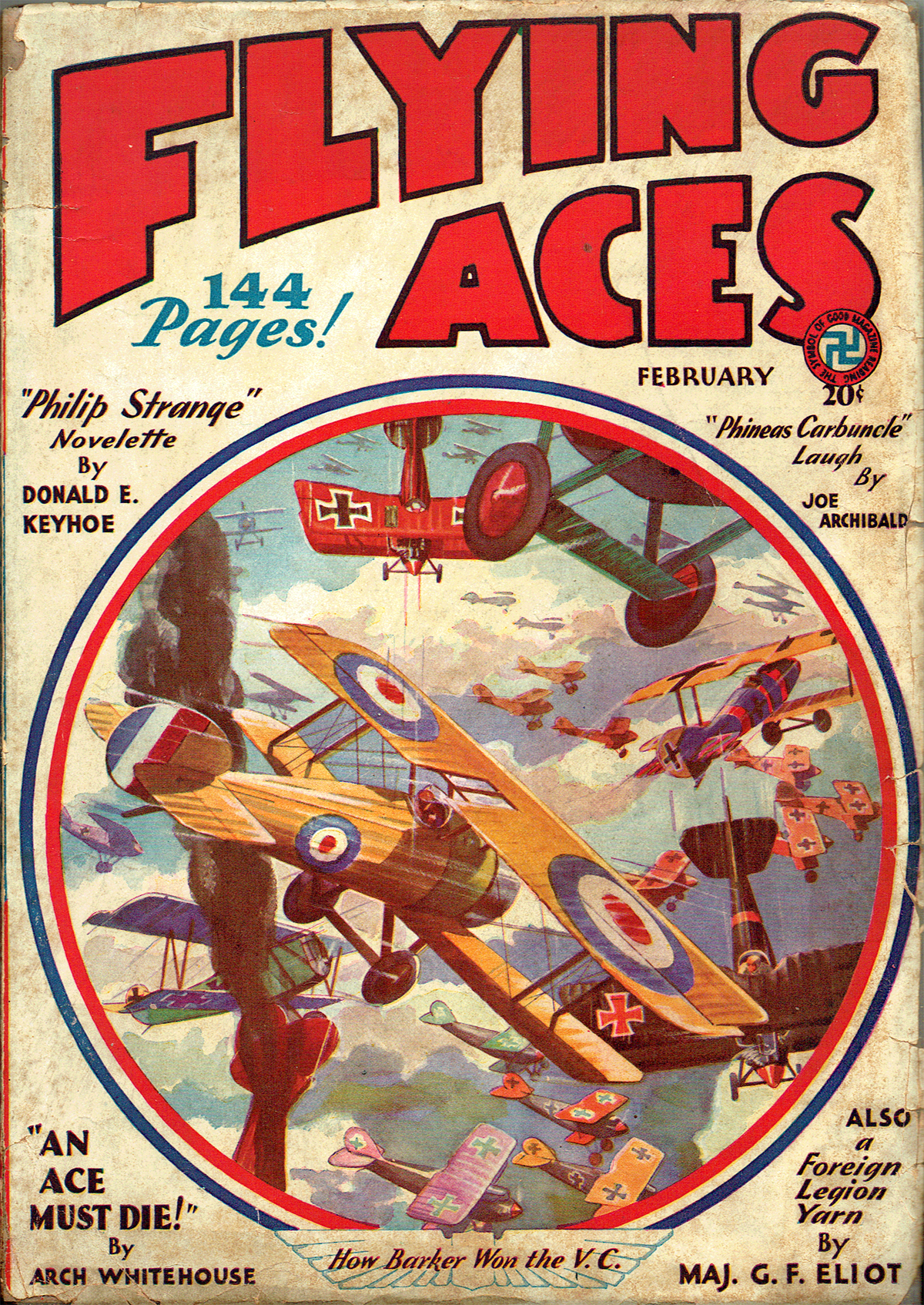 That sound can only mean one thing—that Bachelor of Artifice, Knight of Calamity and an alumnus of Doctor Merlin’s Camelot College for Conjurors is back to vex not only the Germans, but the Americans—the Ninth Pursuit Squadron in particular—as well. Yes it’s the marvel from Boonetown, Iowa himself—Lieutenant Phineas Pinkham!
That sound can only mean one thing—that Bachelor of Artifice, Knight of Calamity and an alumnus of Doctor Merlin’s Camelot College for Conjurors is back to vex not only the Germans, but the Americans—the Ninth Pursuit Squadron in particular—as well. Yes it’s the marvel from Boonetown, Iowa himself—Lieutenant Phineas Pinkham!  a story by Orlando Rigoni. Rigoni was a very prolific author of western and flying stories appearing in such magazines as Battle Birds, Dare-Devil Aces, Sky Birds, War Birds, Fighting Aces, Sky Fighters, Western Aces, Real Western Round-Up, Thrilling Sports, Air Trails, Western Romances, The Lone Eagle and Flying Acesamong others from roughly 1934 to 1948. He went on to have his stories appear in the slicks; wrote radio and movie scripts; write numerous western novels; and gothic romance novels using the pseudonym “Leslie Aimes.”
a story by Orlando Rigoni. Rigoni was a very prolific author of western and flying stories appearing in such magazines as Battle Birds, Dare-Devil Aces, Sky Birds, War Birds, Fighting Aces, Sky Fighters, Western Aces, Real Western Round-Up, Thrilling Sports, Air Trails, Western Romances, The Lone Eagle and Flying Acesamong others from roughly 1934 to 1948. He went on to have his stories appear in the slicks; wrote radio and movie scripts; write numerous western novels; and gothic romance novels using the pseudonym “Leslie Aimes.”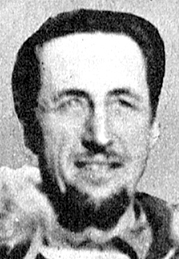 ORLANDO RIGONI, author of “I Want to Know Why” in this issue, appears at the left in a photograph taken in the Yukon last winter while he was working on the Alcan Highway, which, as you doubtless know, is the new road through Canada connecting the United States and Alaska. He is a writer by trade and was working on the road to get material for a novel for young people.
ORLANDO RIGONI, author of “I Want to Know Why” in this issue, appears at the left in a photograph taken in the Yukon last winter while he was working on the Alcan Highway, which, as you doubtless know, is the new road through Canada connecting the United States and Alaska. He is a writer by trade and was working on the road to get material for a novel for young people.
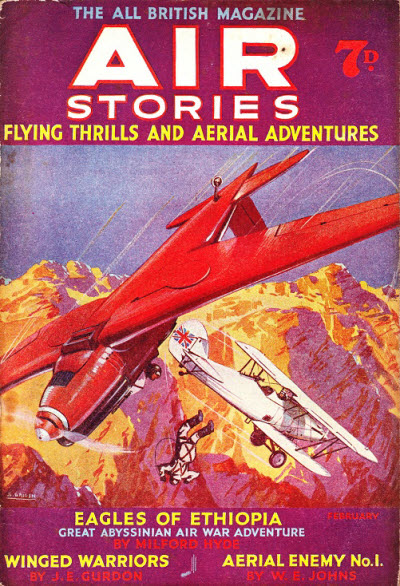 a story from the pen of British Ace,
a story from the pen of British Ace,  exciting air adventure with Rusty Wade from the pen of Frank Richardson Pierce. Pierce is probably best remembered for his prolific career in the Western Pulps. Writing under his own name as well as two pen names—Erle Stanly Pierce and Seth Ranger. Pierce’s career spanned fifty years and produced over 1,500 short stories, with over a thousand of these appearing in the pages of Argosy and the Saturday Evening Post.
exciting air adventure with Rusty Wade from the pen of Frank Richardson Pierce. Pierce is probably best remembered for his prolific career in the Western Pulps. Writing under his own name as well as two pen names—Erle Stanly Pierce and Seth Ranger. Pierce’s career spanned fifty years and produced over 1,500 short stories, with over a thousand of these appearing in the pages of Argosy and the Saturday Evening Post. 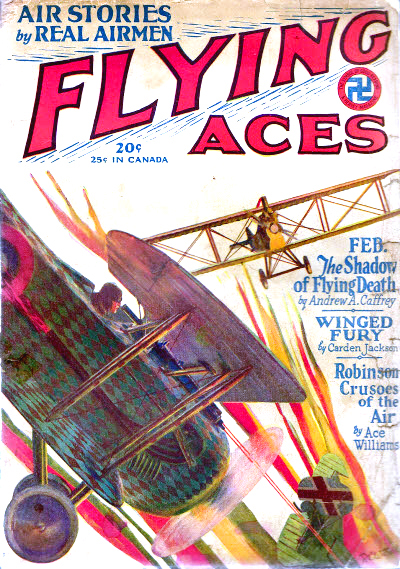 another story by Franklin M. Ritchie. Ritchie only wrote aviation yarns and his entire output—roughly three dozen stories—was between 1927 and 1930. Today we have another one from the lawyer who wrote pulp stories on the side to satisfy his yen for flying. From an early issue of Flying Aces, Ritchie gives us a tale of bomber Jim Barker who longed to show everyone that even a bombing pilot can get Germany’s most ruthless Ace, by any means necessary! From the February 1929 issue of Flying Aces, it’s Franklin M. Ritchie’s “Say It With Bombs!”
another story by Franklin M. Ritchie. Ritchie only wrote aviation yarns and his entire output—roughly three dozen stories—was between 1927 and 1930. Today we have another one from the lawyer who wrote pulp stories on the side to satisfy his yen for flying. From an early issue of Flying Aces, Ritchie gives us a tale of bomber Jim Barker who longed to show everyone that even a bombing pilot can get Germany’s most ruthless Ace, by any means necessary! From the February 1929 issue of Flying Aces, it’s Franklin M. Ritchie’s “Say It With Bombs!”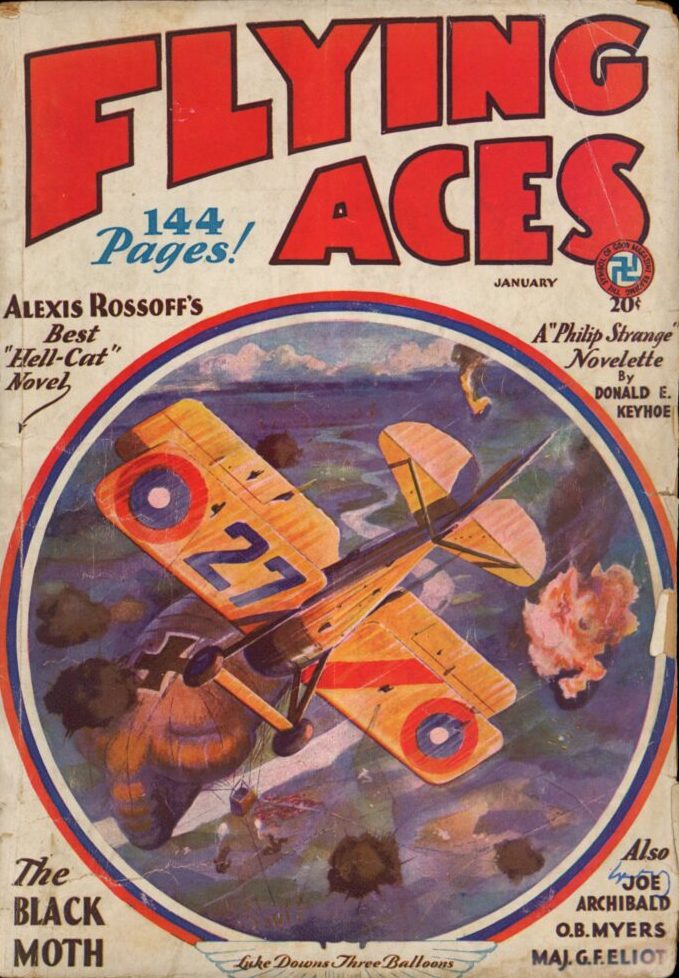 That sound can only mean one thing—that Bachelor of Artifice, Knight of Calamity and an alumnus of Doctor Merlin’s Camelot College for Conjurors is back to vex not only the Germans, but the Americans—the Ninth Pursuit Squadron in particular—as well. Yes it’s the marvel from Boonetown, Iowa himself—Lieutenant Phineas Pinkham!
That sound can only mean one thing—that Bachelor of Artifice, Knight of Calamity and an alumnus of Doctor Merlin’s Camelot College for Conjurors is back to vex not only the Germans, but the Americans—the Ninth Pursuit Squadron in particular—as well. Yes it’s the marvel from Boonetown, Iowa himself—Lieutenant Phineas Pinkham! 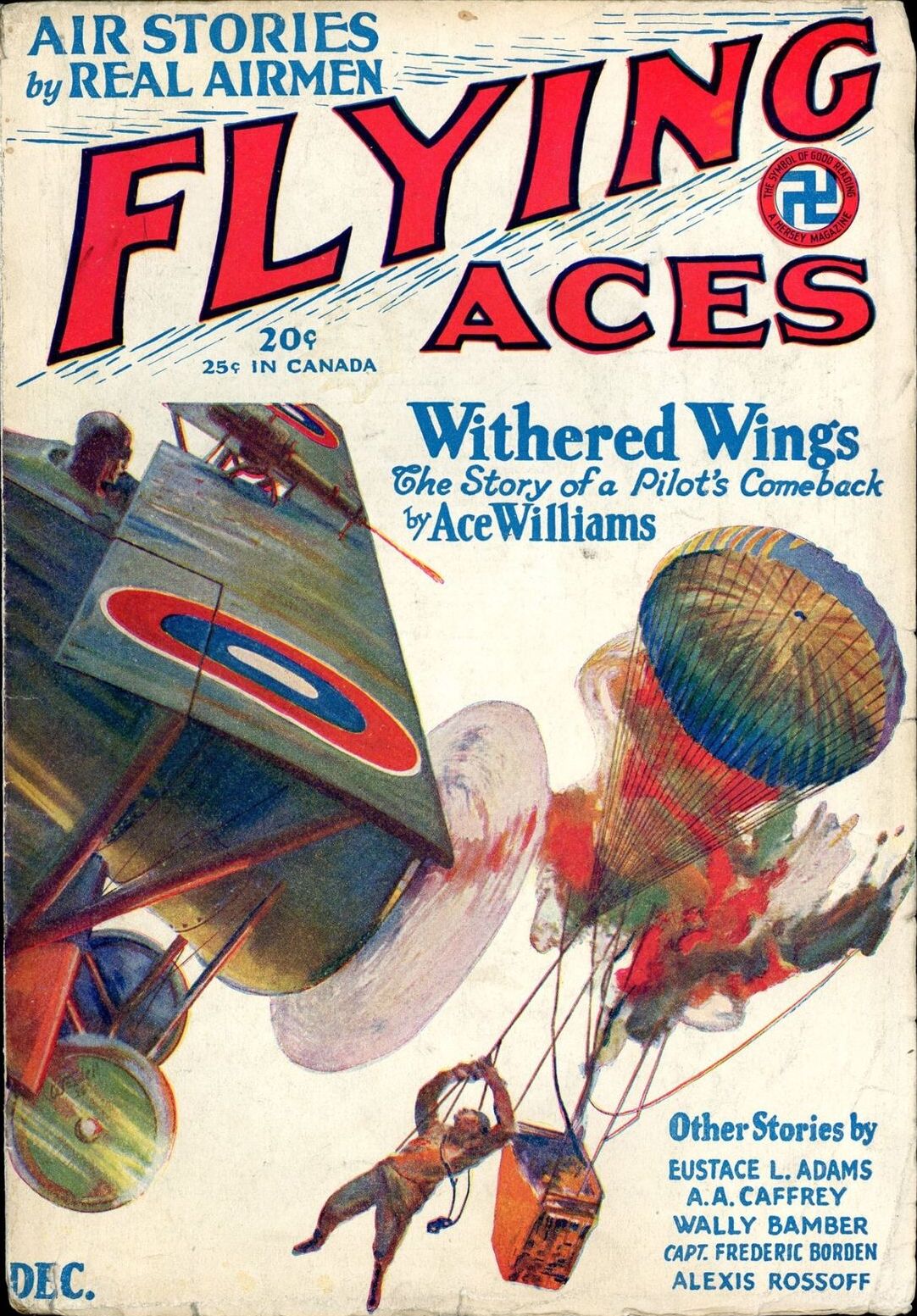 another story from one of the new flight of authors on the site this year—Andrew A. Caffrey. Caffrey, who was in the American Air Service in France during The Great War and worked for the air mail service upon his return, was a prolific author of aviation and adventure stories for both the pulps and slicks from the 1920’s through 1950. Here Caffrey tells the tale of Lieutenant Harry Pond.
another story from one of the new flight of authors on the site this year—Andrew A. Caffrey. Caffrey, who was in the American Air Service in France during The Great War and worked for the air mail service upon his return, was a prolific author of aviation and adventure stories for both the pulps and slicks from the 1920’s through 1950. Here Caffrey tells the tale of Lieutenant Harry Pond. 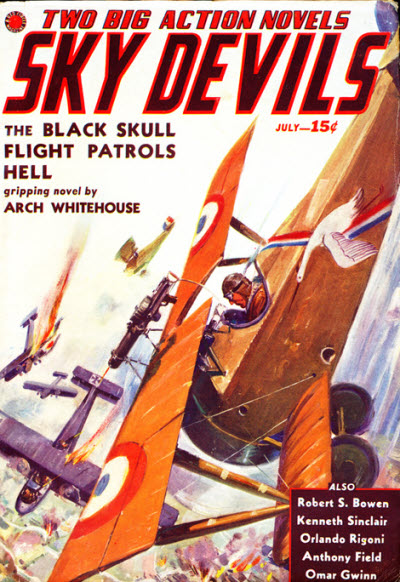 a story by Kenneth Sinclair. Born in 1910, Sinclair had a lengthy run in the pulps. Writing mainly aviation and western stories, his first was in 1932 and his last in 1956. He also published a couple boys adventure novels in the ’50’s where the back covers state Sinclair is a mechanical engineer as well as writer. He died in 1980. “Spandau Salute” finds Terry Ralton going down behind enemy lines convinced that his plane had been tampered with back at the field. If he could just get his hands on that Hawley… And there he was at the German drome he finds himself at!
a story by Kenneth Sinclair. Born in 1910, Sinclair had a lengthy run in the pulps. Writing mainly aviation and western stories, his first was in 1932 and his last in 1956. He also published a couple boys adventure novels in the ’50’s where the back covers state Sinclair is a mechanical engineer as well as writer. He died in 1980. “Spandau Salute” finds Terry Ralton going down behind enemy lines convinced that his plane had been tampered with back at the field. If he could just get his hands on that Hawley… And there he was at the German drome he finds himself at!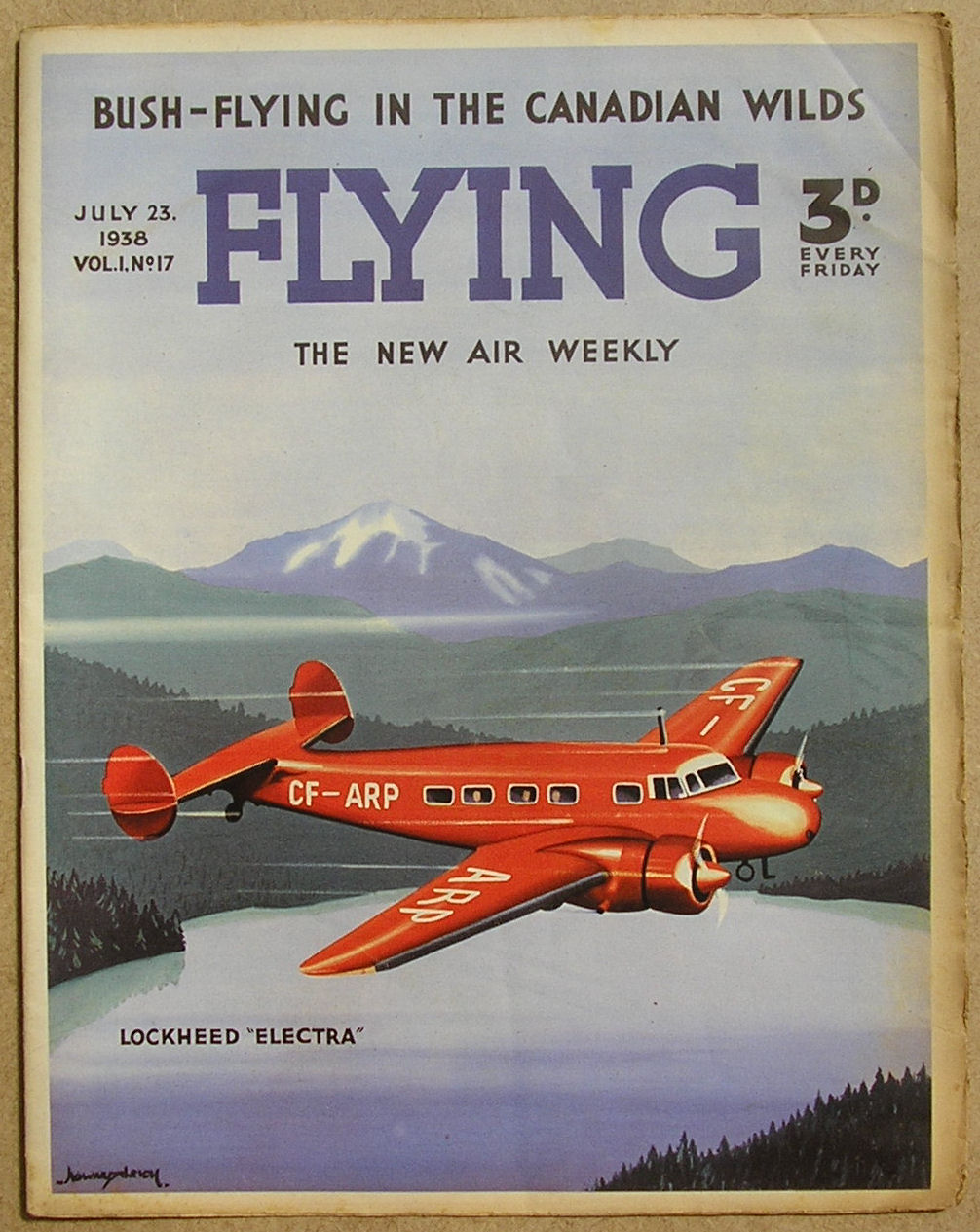 weekly paper of all things aviation, started up in England in 1938, amongst the articles and stories and photo features was an illustrative feature called “Heroes of the Air.” It was a full page illustration by S. Drigin of the events surrounding how the pictured Ace got their Victoria Cross along with a brief explanatory note.
weekly paper of all things aviation, started up in England in 1938, amongst the articles and stories and photo features was an illustrative feature called “Heroes of the Air.” It was a full page illustration by S. Drigin of the events surrounding how the pictured Ace got their Victoria Cross along with a brief explanatory note. 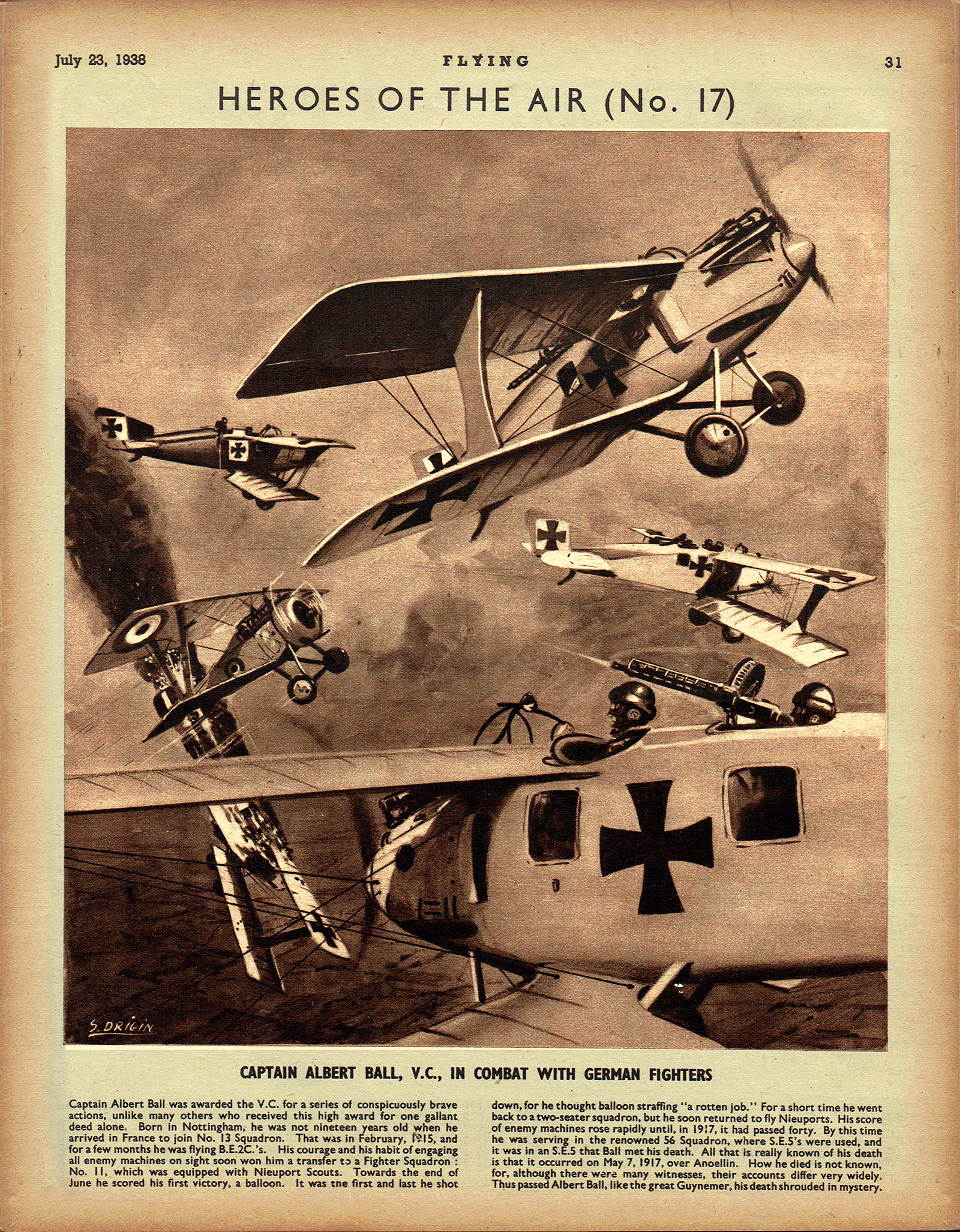
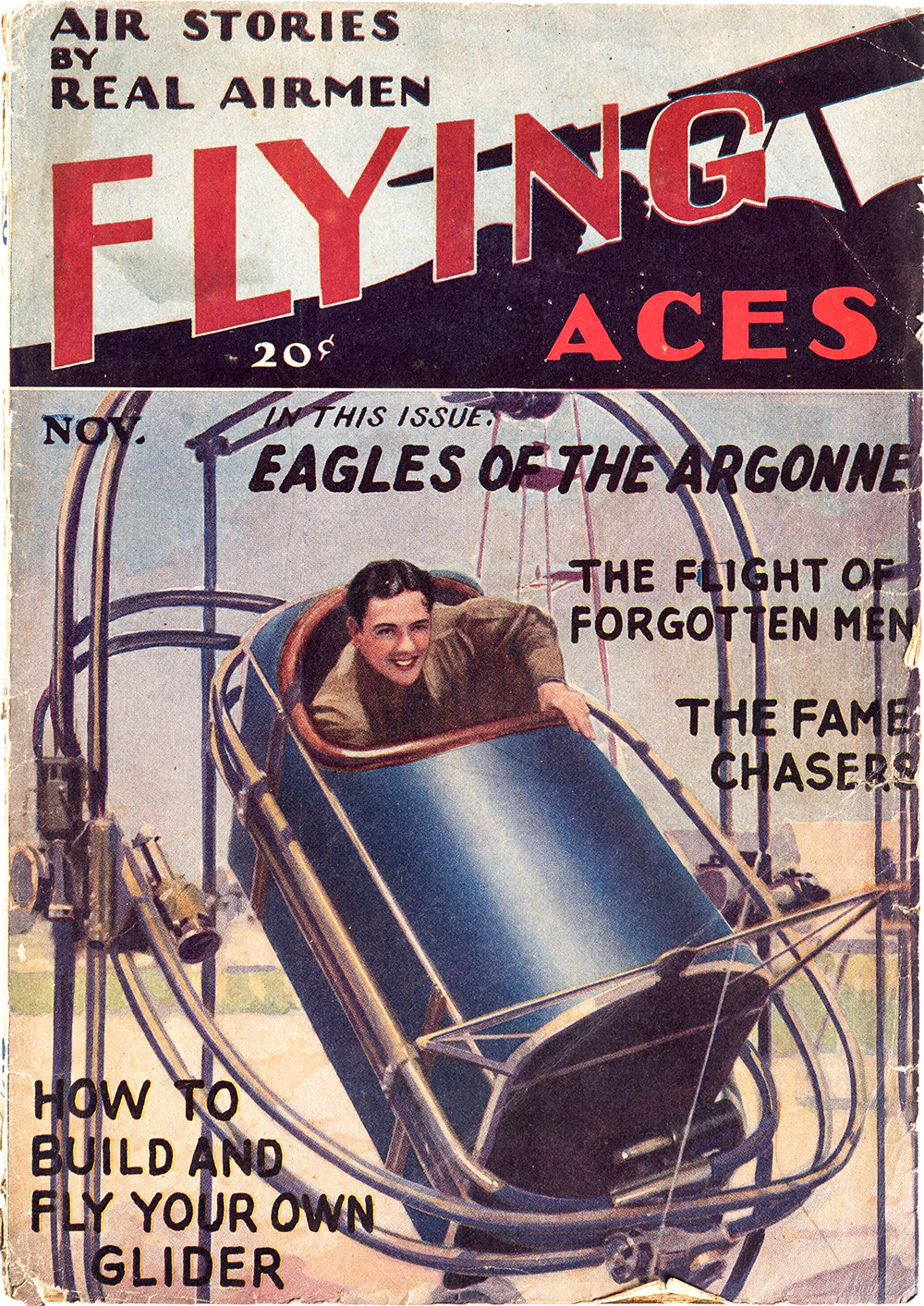 exciting air adventure from the pen of F.H. Griggs, Jr. Griggs is a rather enigmatic figure with just two stories to his name from those issues indexed by Fiction Mags.
exciting air adventure from the pen of F.H. Griggs, Jr. Griggs is a rather enigmatic figure with just two stories to his name from those issues indexed by Fiction Mags. 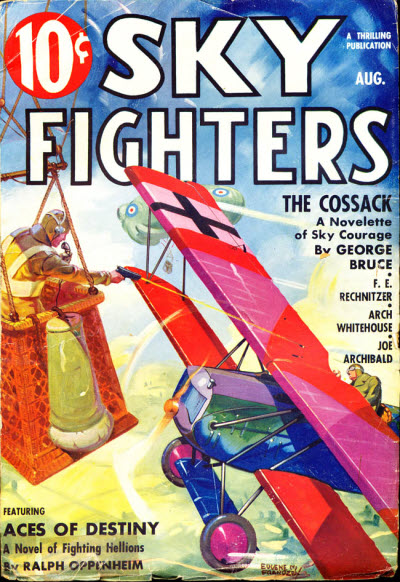 Mosquito Month we have a non-Mosquitoes story from the pen of Ralph Oppenheim. In the mid thirties, Oppenheim wrote a half dozen stories for Sky Fighters featuring Lt. “Streak” Davis. Davis—ace and hellion of the 25th United States Pursuit Squadron—was a fighter, and the speed with which he hurled his plane to the attack, straight and true as an arrow, had won him his soubriquet. Once more it’s a battle against time—B Flight is sent out on a perilous mission to destroy the new Boche anti-tank gun munitions factory by noon in hopes of preventing a massacre when the Allies push forward in their new Whippet tanks. However, after B flight has taken off, Streak learns a spy may have fouled their mission somehow and flies off like a streak to stop them before it’s too late! From the August 1936 issue of Sky Fighters it’s Ralph Oppenheim’s steak Davis in “Aces of Destiny!”
Mosquito Month we have a non-Mosquitoes story from the pen of Ralph Oppenheim. In the mid thirties, Oppenheim wrote a half dozen stories for Sky Fighters featuring Lt. “Streak” Davis. Davis—ace and hellion of the 25th United States Pursuit Squadron—was a fighter, and the speed with which he hurled his plane to the attack, straight and true as an arrow, had won him his soubriquet. Once more it’s a battle against time—B Flight is sent out on a perilous mission to destroy the new Boche anti-tank gun munitions factory by noon in hopes of preventing a massacre when the Allies push forward in their new Whippet tanks. However, after B flight has taken off, Streak learns a spy may have fouled their mission somehow and flies off like a streak to stop them before it’s too late! From the August 1936 issue of Sky Fighters it’s Ralph Oppenheim’s steak Davis in “Aces of Destiny!”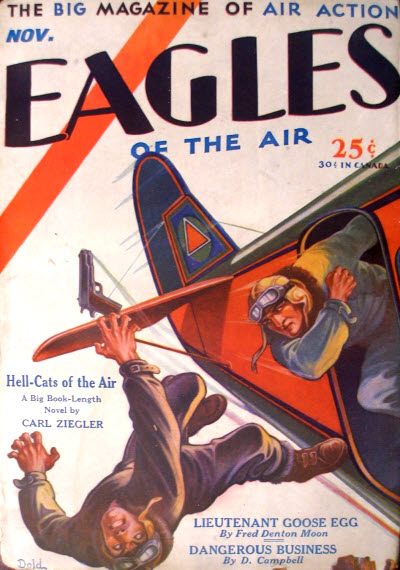 of three stories featuring D. Campbell’s The Three Wasps—stories plagiarized right from The Three Mosquitoes! So instead of the young impetuous leader Kirby of the Mosquitoes, we have the young and impetuous Gary heading up the Wasps. Similarly, Campbell changed “Shorty” Carn to “Shorty” Keen complete with briar pipe and eldest and wisest Travis to Cooper. This time we have their first of five appearances in Harold Hersey’s Eagles of the Air, a short lived pulp that didn’t even run a year. From October 1929 to August 1930, Eagles of the Air had nine issues; The Wasps ran in five of them.
of three stories featuring D. Campbell’s The Three Wasps—stories plagiarized right from The Three Mosquitoes! So instead of the young impetuous leader Kirby of the Mosquitoes, we have the young and impetuous Gary heading up the Wasps. Similarly, Campbell changed “Shorty” Carn to “Shorty” Keen complete with briar pipe and eldest and wisest Travis to Cooper. This time we have their first of five appearances in Harold Hersey’s Eagles of the Air, a short lived pulp that didn’t even run a year. From October 1929 to August 1930, Eagles of the Air had nine issues; The Wasps ran in five of them.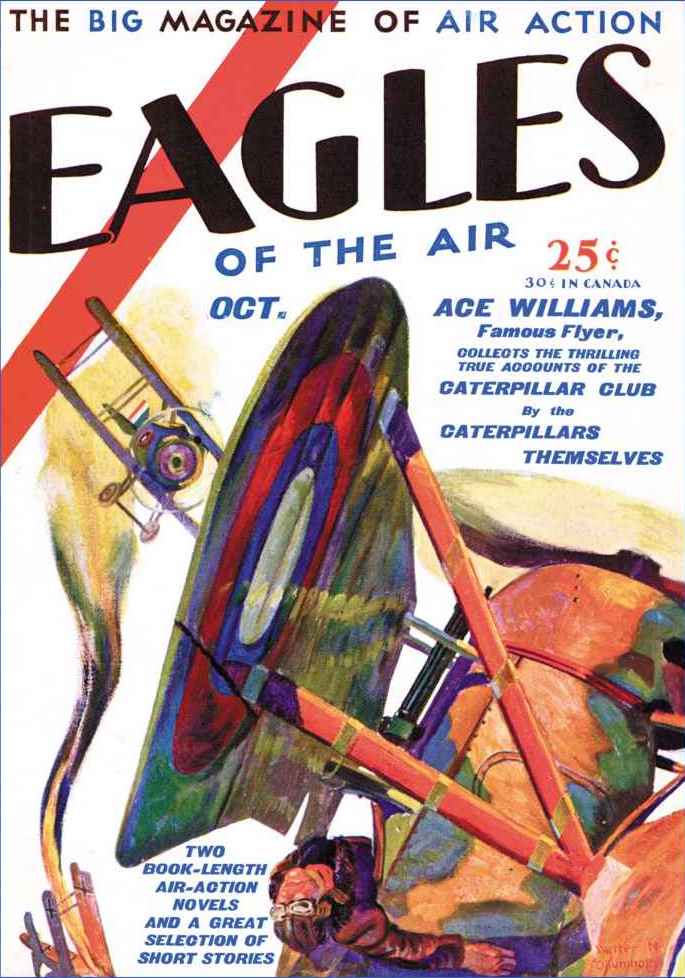 of three stories featuring D. Campbell’s The Three Wasps—stories plagiarized right from The Three Mosquitoes! So instead of the young impetuous leader Kirby of the Mosquitoes, we have the young and impetuous Gary heading up the Wasps. Similarly, Campbell changed “Shorty” Carn to “Shorty” Keen complete with briar pipe and eldest and wisest Travis to Cooper. This time we have their first of five appearances in Harold Hersey’s Eagles of the Air, a short lived pulp that didn’t even run a year. From October 1929 to August 1930, Eagles of the Air had nine issues; The Wasps ran in five of them.
of three stories featuring D. Campbell’s The Three Wasps—stories plagiarized right from The Three Mosquitoes! So instead of the young impetuous leader Kirby of the Mosquitoes, we have the young and impetuous Gary heading up the Wasps. Similarly, Campbell changed “Shorty” Carn to “Shorty” Keen complete with briar pipe and eldest and wisest Travis to Cooper. This time we have their first of five appearances in Harold Hersey’s Eagles of the Air, a short lived pulp that didn’t even run a year. From October 1929 to August 1930, Eagles of the Air had nine issues; The Wasps ran in five of them.




 to the squadron and he can’t stand pilots who “grand-stand” which is the Mosquitoes stock-in-trade and boy do they catch hell when they get on the C.O.’s wrong side—that is until the C.O. gets in a jam and it’s trick flying that’ll save him when the Boche attack!
to the squadron and he can’t stand pilots who “grand-stand” which is the Mosquitoes stock-in-trade and boy do they catch hell when they get on the C.O.’s wrong side—that is until the C.O. gets in a jam and it’s trick flying that’ll save him when the Boche attack!